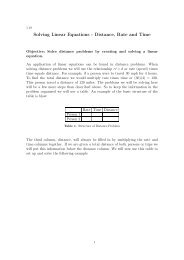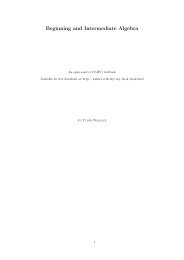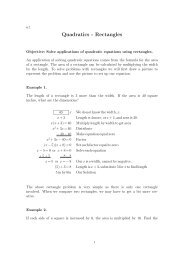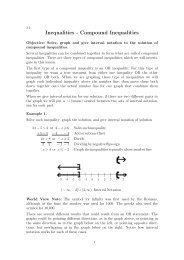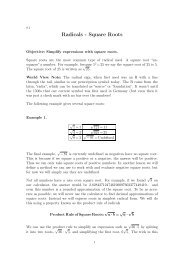Solving Linear Equations - Absolute Value - Wallace Math Courses
Solving Linear Equations - Absolute Value - Wallace Math Courses
Solving Linear Equations - Absolute Value - Wallace Math Courses
You also want an ePaper? Increase the reach of your titles
YUMPU automatically turns print PDFs into web optimized ePapers that Google loves.
1.6<br />
<strong>Solving</strong> <strong>Linear</strong> <strong>Equations</strong> - <strong>Absolute</strong> <strong>Value</strong><br />
Objective: Solve linear absolute value equations.<br />
When solving equations with absolute value we can end up with more than one<br />
possible answer. This is because what is in the absolute value can be either negative<br />
or positive and we must account for both possibilities when solving equations.<br />
This is illustrated in the following example.<br />
Example 1.<br />
|x| =7 <strong>Absolute</strong> value can be positive or negative<br />
x =7 or x = − 7 Our Solution<br />
Notice that we have considered two possibilities, both the positive and negative.<br />
Either way, the absolute value of our number will be positive 7.<br />
World View Note: The first set of rules for working with negatives came from<br />
7th century India. However, in 1758, almost a thousand years later, British mathematician<br />
Francis Maseres claimed that negatives “Darken the very whole doctrines<br />
of the equations and make dark of the things which are in their nature<br />
excessively obvious and simple.”<br />
When we have absolute values in our problem it is important to first isolate the<br />
absolute value, then remove the absolute value by considering both the positive<br />
and negative solutions. Notice in the next two examples, all the numbers outside<br />
of the absolute value are moved to the other side first before we remove the absolute<br />
value bars and consider both positive and negative solutions.<br />
Example 2.<br />
Example 3.<br />
5 + |x| =8 Notice absolute value is not alone<br />
− 5 − 5 Subtract 5 from both sides<br />
|x| =3 <strong>Absolute</strong> value can be positive or negative<br />
x =3 or x = − 3 Our Solution<br />
− 4|x| = − 20 Notice absolute value is not alone<br />
− 4 − 4 Divide both sides by − 4<br />
1
|x| = 5 <strong>Absolute</strong> value can be positive or negative<br />
x =5 or x = − 5 Our Solution<br />
Notice we never combine what is inside the absolute value with what is outside<br />
the absolute value. This is very important as it will often change the final result<br />
to an incorrect solution. The next example requires two steps to isolate the absolute<br />
value. The idea is the same as a two-step equation, add or subtract, then<br />
multiply or divide.<br />
Example 4.<br />
5|x| − 4=26 Notice the absolute value is not alone<br />
+ 4 + 4 Add4to both sides<br />
5|x| = 30 <strong>Absolute</strong> value still not alone<br />
5 5 Divide both sides by 5<br />
|x| =6 <strong>Absolute</strong> value can be positive or negative<br />
x =6 or x = − 6 Our Solution<br />
Again we see the same process, get the absolute value alone first, then consider<br />
the positive and negative solutions. Often the absolute value will have more than<br />
just a variable in it. In this case we will have to solve the resulting equations<br />
when we consider the positive and negative possibilities. This is shown in the next<br />
example.<br />
Example 5.<br />
|2x − 1| = 7 <strong>Absolute</strong> value can be positive or negative<br />
2x − 1 =7 or 2x − 1=−7 Two equations to solve<br />
Now notice we have two equations to solve, each equation will give us a different<br />
solution. Both equations solve like any other two-step equation.<br />
2x − 1=7<br />
+ 1 + 1<br />
2x = 8<br />
2 2<br />
x = 4<br />
or<br />
2<br />
2x − 1=−7<br />
+ 1 + 1<br />
2x = − 6<br />
2 2<br />
x = − 3
Thus, from our previous example we have two solutions, x = 4 or x = − 3.<br />
Again, it is important to remember that the absolute value must be alone first<br />
before we consider the positive and negative possibilities. This is illustrated in<br />
below.<br />
Example 6.<br />
2 − 4|2x + 3| = − 18<br />
To get the absolute value alone we first need to get rid of the 2 by subtracting,<br />
then divide by − 4. Notice we cannot combine the 2 and − 4 becuase they are<br />
not like terms, the − 4 has the absolute value connected to it. Also notice we do<br />
not distribute the − 4 into the absolute value. This is because the numbers outside<br />
cannot be combined with the numbers inside the absolute value. Thus we get<br />
the absolute value alone in the following way:<br />
2 − 4|2x+3| = − 18 Notice absolute value is not alone<br />
− 2 − 2 Subtract2from both sides<br />
− 4|2x+3| = − 20 <strong>Absolute</strong> value still not alone<br />
− 4 − 4 Divide both sides by − 4<br />
|2x +3| =5 Absoloute value can be positive or negative<br />
2x +3=5 or 2x + 3=−5 Two equations to solve<br />
Now we just solve these two remaining equations to find our solutions.<br />
2x + 3=5<br />
− 3 − 3<br />
2x = 2<br />
2 2<br />
x = 1<br />
We now have our two solutions, x = 1 and x = − 4.<br />
or<br />
2x + 3=−5<br />
− 3 − 3<br />
2x = − 8<br />
2 2<br />
x = − 4<br />
As we are solving absolute value equations it is important to be aware of special<br />
cases. Remember the result of an absolute value must always be positive. Notice<br />
what happens in the next example.<br />
3
Example 7.<br />
7+|2x − 5| =4 Notice absolute value is not alone<br />
− 7 − 7 Subtract 7 from both sides<br />
|2x − 5| = − 3 Result of absolute value is negative!<br />
Notice the absolute value equals a negative number! This is impossible with absolute<br />
value. When this occurs we say there is no solution or ∅.<br />
One other type of absolute value problem is when two absolute values are equal to<br />
eachother. We still will consider both the positive and negative result, the difference<br />
here will be that we will have to distribute a negative into the second absolute<br />
value for the negative possibility.<br />
Example 8.<br />
|2x − 7| = |4x + 6| <strong>Absolute</strong> value can be positive or negative<br />
2x − 7 =4x +6 or 2x − 7=− (4x + 6) makesecondpartofsecondequationnegative<br />
Notice the first equation is the positive possibility and has no significant difference<br />
other than the missing absolute value bars. The second equation considers<br />
the negative possibility. For this reason we have a negative in front of the expression<br />
which will be distributed through the equation on the first step of solving. So<br />
we solve both these equations as follows:<br />
2x − 7=4x + 6<br />
− 2x − 2x<br />
− 7=2x +6<br />
− 6 − 6<br />
− 13 = 2x<br />
2 2<br />
− 13<br />
= x<br />
2<br />
This gives us our two solutions, x =<br />
or<br />
− 13<br />
2<br />
2x − 7=−(4x +6)<br />
2x − 7=−4x − 6<br />
+ 4x + 4x<br />
6x − 7=−6<br />
+ 7 + 7<br />
6x = 1<br />
6 6<br />
x = 1<br />
6<br />
or x = 1<br />
6 .<br />
Beginning and Intermediate Algebra by Tyler <strong>Wallace</strong> is licensed under a Creative Commons<br />
Attribution 3.0 Unported License. (http://creativecommons.org/licenses/by/3.0/)<br />
4
1.6 Practice - <strong>Absolute</strong> <strong>Value</strong> <strong>Equations</strong><br />
Solve each equation.<br />
1) |x| =8<br />
3) |b| =1<br />
5) |5+8a| = 53<br />
7) |3k + 8| =2<br />
9) |9+7x| = 30<br />
11) | 8+6m| = 50<br />
13) | 6 − 2x| = 24<br />
15) − 7| − 3 − 3r| = − 21<br />
17) 7| − 7x − 3| = 21<br />
19)<br />
| − 4b − 10|<br />
8<br />
= 3<br />
21) 8|x + 7| − 3=5<br />
23) 5|3 +7m| + 1=51<br />
25) 3+5|8 − 2x| = 63<br />
27) |6b − 2| + 10 = 44<br />
29) − 7+8| − 7x − 3| = 73<br />
31) |5x + 3| = |2x − 1|<br />
33) |3x − 4| = |2x +3|<br />
4x − 2 6x + 3<br />
35) | | = | |<br />
5 2<br />
2) |n| = 7<br />
4) |x| =2<br />
6) |9n+8| = 46<br />
8) |3 −x| =6<br />
10) |5n + 7| = 23<br />
12) |9p +6| = 3<br />
14) |3n − 2| = 7<br />
16) |2+2b| + 1=3<br />
18)<br />
| − 4 − 3n|<br />
4<br />
=2<br />
20) 8|5p +8| − 5 = 11<br />
22) 3 − |6n +7| = − 40<br />
24) 4|r +7| + 3=59<br />
26) 5+8| − 10n − 2| = 101<br />
28) 7|10v − 2| − 9=5<br />
30) 8|3 − 3n| − 5=91<br />
32) |2+3x| = |4 − 2x|<br />
2x − 5 3x + 4<br />
34) | | = | |<br />
3 2<br />
36) |<br />
3x +2 2x − 3<br />
| = | |<br />
2 3<br />
Beginning and Intermediate Algebra by Tyler <strong>Wallace</strong> is licensed under a Creative Commons<br />
Attribution 3.0 Unported License. (http://creativecommons.org/licenses/by/3.0/)<br />
5
1.6<br />
1) 8, − 8<br />
2) 7, − 7<br />
3) 1, − 1<br />
4) 2, − 2<br />
5) 6, − 29<br />
4<br />
6) 38<br />
, − 6 9<br />
7) − 2, − 10<br />
3<br />
8) − 3, 9<br />
9) 3, − 39<br />
7<br />
10) 16<br />
, − 6<br />
5<br />
11) 7, − 29<br />
3<br />
12) − 1<br />
, − 1<br />
3<br />
13) − 9, 15<br />
Answers to <strong>Absolute</strong> <strong>Value</strong> <strong>Equations</strong><br />
14) 3, − 5<br />
3<br />
15) − 2,0<br />
16) 0, − 2<br />
17) − 6<br />
, 0<br />
7<br />
18) − 4, 4<br />
3<br />
19) − 17 7<br />
,<br />
2 2<br />
20) − 6<br />
, − 2<br />
5<br />
21) − 6, − 8<br />
22) 6, − 25<br />
3<br />
23) 1, − 13<br />
7<br />
24) 7, − 21<br />
25) − 2, 10<br />
26) − 7<br />
, 1<br />
5<br />
27) 6, − 16<br />
3<br />
28) 2<br />
, 0<br />
5<br />
29) − 13<br />
, 1<br />
7<br />
30) − 3, 5<br />
31) − 4 2<br />
, −<br />
3 7<br />
32) − 6, 2<br />
5<br />
33) 7, 1<br />
5<br />
34) − 22 2<br />
, −<br />
5 13<br />
35) − 19 11<br />
, −<br />
22 38<br />
36) 0, − 12<br />
5<br />
Beginning and Intermediate Algebra by Tyler <strong>Wallace</strong> is licensed under a Creative Commons<br />
Attribution 3.0 Unported License. (http://creativecommons.org/licenses/by/3.0/)<br />
6



